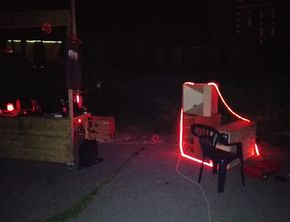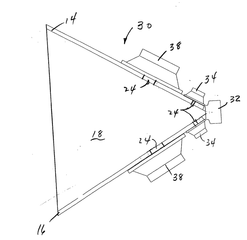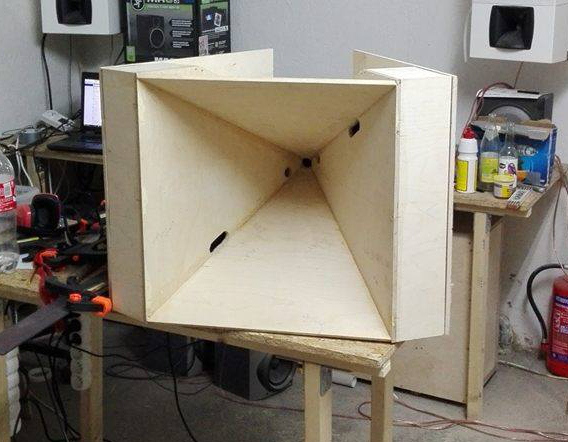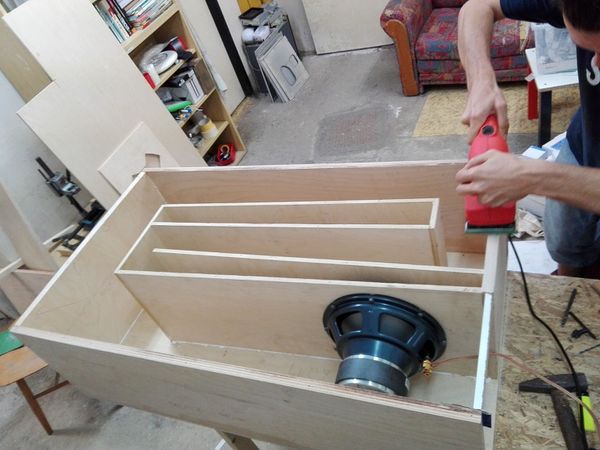Soundsystem
Looks like we're a part of Brno's hifi clique now! olol
Contents
What is a soundsystem?
A soundsystem is a set of devices needed for sound reinforcement applications - situations where we need to cover some not too small area with loud sound that is as high fidelity as possible and with as little loudness variation as possible. Obvious examples are parties, concerts, talks for more people etc. It generally consists of three types of devices: speakers, amplifiers and speaker management devices used to properly split the sound into different channels/bands, equalize, limit the loudness and possibly other things using digital signal procesing (DSP).
While amps and DSPs used in most of todays soundsystems are of good quality, the quality of speakers (or more precisely speaker stacks, and their relation to overall sound) is often very poor even in the most modern and expensive systems, so the goal of this particular soundsystem is to use state of the art speaker technology and produce some next-level-shit high-end sound.
Amps & Speaker management
There is no need for more than 100W per band&channel except for subwoofers, so integrated AB class amps are currently used and there is no incentive to change except for power efficiency. A new box with proper shielding and better cooling system is needed. A class D subwoofer amp capable of cca 1kW output is in development.
Speaker management is done on PC with a multichannel soundcard for prototyping, first version of proper DSP board is almost done. It will use DSP chips by Analog Devices visually programmable with Sigma Studio and support IIR only, so no time delays yet. Final DSP version will use a more expensive DSP chip with FIR support needed for completely linear phase, time alignment of everything and directivity control of subwoofers.
Speakers
Important factors
- Linear power response approximately from 30 Hz to 20 kHz - there's some leeway on the high end, and on the low end this generally means about -3 dB at 30 Hz. Chosen arbitrarily based on dubstep experience. This typically needs 3-way main speakers and subwoofers. Since the general quality of subwoofers in commercial systems is not as bad as that of mains, we will mostly talk about the mains, which means frequencies above cca 100 Hz.
- Linear frequency response on-axis and off-axis (to a degree), meaning both on the sides and above/below, because the speaker is typically above head-level and aimed down
- High volume (usually measured in dB SPL) with insignificant distortion
- Controlled directivity - most of the frequency spectrum should only radiate inside a given angle
Problems of typical solutions
- Typical 2-way boxes - speakers containing a horn-loaded compression driver and a woofer, usually with a bass port.
- Compression drivers have to be hornloaded, but most commercial horns either don't provide constant directivity, cause diffractions or both, producing non-linear frequency response and "horn honk". This can be solved on the horizontal plane by using a minimum-diffraction constant directivity horn, an oblate spheroid, although it is not trivial to build.
- It needs expensive parts if we want it to play loud - the driver has to handle playing pretty low due to only having 2 bands. Adding to that, an oblate spheroid horn doesn't provide the best horn-loading and lowers the sensitivity a bit.
- The vertical directivity is not good. Around the crossover frequency sound is radiated from both the driver and the woofer, which sums up fine on axis, but creates problems above and below axis, typically large nulls in the frequency respose.
- 3-way boxes with constant directivity horns on the high frequency driver and midwoofer largely solve the loudness problem, but not the directivity problem and are huge and heavy.
- Line arrays - vertical lines of speakers used by outdoor festivals and large indoor venues (a common number is 12 speakers per side), recently also often 2-3 speakers per side in smaller to mid-sized clubs.
- Popular because they can provide very even loudness over a large area
- Behaves like a line-source from a certain frequency, which means its vertical directivity control is good.
- It also means that the volume of high frequencies falls off slower with distance than the volume of low frequencies
- Suffers from comb filtering (creating by interference between the speakers), which is not very audible when staying still, but rather prominent when moving around, and creates "muffled sound" outside when there is wind, because the interference patterns change
- This also introduces temporal smearing, making the "detailness" of everything (intelligibility of voices etc.) rather bad
- Needs lots of DSP, setting up is more complicated
- Some of these problems have solutions that are unique and interesting (Danley Jericho horns, Don Keele's Constant Beamwidth Transducers), but also huge and expensive and difficult to build
- Stacks in the soundsystem or modern (for example Funktion One) style - smaller or larger towers of boxes, often one type of box per band (up to 5 bands) with several pieces of each type, different enclosure types for different bands
- Oldschool soundsystem towers make no sense in general, usually built without any regard for directivity and interference between bands, poor frequency response...
- Modern stacks popularized mostly by Funktion One are better, but still built with maximum SPL in mind at the cost of fidelity
- More speakers always means more problems with phasing around crossovers, comb filtering, difficult setup if we care about fidelity
The chosen solution - Synergy Horns
- Invented by Tom Danley of Danley Sound Labs (picture from his patent application above)
- Constant directivity multi-way point-source horns
- A 4-sided horn in the shape of a pyramid with a small flare at the end provides constant directivity
- A compression driver for high frequencies is located at the throat (=tip, beginning of the pyramid). The throat end contains a short transition between the pyramid and a conus to reduce diffractions (the first few centimeters are the most important)
- Midwoofers and woofers are connected through holes at the sides of the horn
- The holes through the horn sides, together with the space between the woofer's conus itself and the flat side of the pyramid, work as an acoustical bandpass filter, drastically reducing volume above and below a given passband, thus reducing harmonic distortion (below passband) and distortion from breakups (above passband) without the need for steep electrical fiters
- The holes need to be located at specific distance from the throat - this is to provide horn-loading of the passband without any destructive reflections inside the horn, and to couple the bands to each other - because the drivers are not on a plane, the holes from midwoofers & woofers and the throat can be close enough together to all behave as one large fullrange driver with no phasing issues around the crossover
- The number of woofers & midwoofers is only limited by the space constrains - typically up to 6 of each can fit on one horn, resulting in a box with 13 speakers (6 + 6 + tweeter)
- Thanks to all this the quality of speakers doesn't matter much apart from maximum SPL, frequency response in the passband and distortion in the passband - directivity doesn't matter and behavior outside of passband doesn't matter, and SPL can be made higher by using more speakers
- For more bass output bass ports can be inserted inside the horn as well
- The whole box behaves as one point-source, can be made with almost linear phase as well
- Directivity is constant on both axes, with practical horn sizes down to about 500 Hz
- Radiating angle can be different for vertical and horizontal axis, 90° x 60° is popular
- SPL is typically only limited by the high frequency driver because there are more woofers and midwoofers
- Can be built with passive crossover (one amp per channel, no DSP needed), but it's difficult and imo anachronistic
- When using DSP, the 3 bands can even be perfectly time-aligned, something even most high-end speakers often can't do, and if so, only in one horizontal plane
- It is theoretically possible to do this even without DSP - although the woofers and midwoofers are closer to the listener than the tweeter, the bandpasses add time-delay that can be large enough to compensate (and is in fact often too large)
- Thanks to the constant directivity on both axes and a nice wavefront shape, Synergy Horns can be stacked next to each other for wider coverage with little compromises in overrall fidelity
Our implementation of Synergy Horns
No complete plans exist, the horns have to be fine-tuned for the specific speakers used. A model had to be created and simulated using Hornresp or Akabak, this works rather well up to mids, high frequencies aren't simulated well, which led to some mistakes in the first prototype.
What is done
- First prototype has been built using ultra low-cost parts, price of drivers being about 3300 CZK per box, using 5 drivers in total. 50° x 50° directivity control should work down to about 550 Hz with a bit of a narrowing in the mids due to lack of mouth flare-out, frequency response is cca 100 Hz - 19 kHz
- It has been tested and proven to work in an outdoor party setting, and sounds great even from 100 meters away completely off-axis
- The simulation mostly matches reality with one exception - the midwoofer location is too far away from the throat due to a design mistake, and the right distance is difficult to simulate correctly because it's measured from the inside of the tweeter. The fix will require part of the enclosure to be rebuilt, the old hole plugged and a new one drilled closer to the throat
- Due to above mistake the midwoofers have to be equalized heavily (10+ dB), despite this the box played loudly and cleanly with great dynamics, and the loudness was limited by subwoofer amp. After the fix there should be little equalization needed apart from the tweeter
- The throat is only made into a conus transition by hand, models for precise 3D printed throat are being worked on and will be implemented in 2nd iteration
- Phase & time adjustment has not been done yet, no reason to measure it until the mids are fixed
What is planned
- Fix the mids. This hopefully won't require a completely new box, but it might
- Larger woofers (or twice as many) might be needed. Two 8" per side don't offer enough bass extension right now
- Add a mouth flare and measure the directivity. We know it will be awesome, but it's good to have the data
- Use a precise oblate spheroid to pyramid transition at the throat to minimize the diffractions and higher order modes. This will be an improvement over the original Danley design already and nobody has done it properly so far afaik
- Fill the horn with open-cell foam
- This has been invented by dr. Earl Geddes and is done to reduce the effect of higher order modes, which should essentially made the sound even less horn-like and even more natural sounding
- How it works, simplified: It attentuates the sound a bit, but it attentuates the sound taking the shortest path (=directly out) less than the sound bouncing around inside the horn
- One person on diyaudio forum has done it and subjectively confirmed the effect, nobody else has done this so far afaik
- Precisely measure the phase response and optimize the crossover filters for as linear phase as possible
- Make the box more practical - for durability, easier carrying, mounting on a pole and possibly for partial disassembly of the horn for transport.
Subwoofers
- The status of commercial subwoofer technology is decent, there's some room for inovation in using various array types to influence the directivity and frequency response over an area, especially inside, but not too much in enclosure design
- Many systems use simple bass-reflex boxes, these are easy to design & build and comparatively small and lightweight, but their sensitivity is typically lower, so more expensive drivers and amps are needed.
- For more output & lower distortion, horns are used. Because the length of horns is rather large (up to several meters), the horn is folded several times and fit into a box. This does not cause significant problems for low frequencies.
- Traditional horns are either back-loaded or front-loaded
- Back-loaded horns radiate sound directly with the front side of the conus, and the back side of the conus is loaded into a folded horn, which usually ends at the front, below the driver. Because the back wave is not in phase, it creates dips in the frequency response. A popular example is the super scooper
- Front-loaded horns have the driver mounted in a small closed box, so the back side of the conus is not used, and the front side is horn-loaded into a folded horn
- The horns have to be rather long for true subbass (<50 Hz) capability
- Sometimes hybrid enclosures (hornflex - a shorter horn with the low-end supplemented with a helmholtz resonator) are used
Tapped horns
- Also invented by Tom Danley
- Essentialy combine the front-loaded horns and back-loaded horns
- The front of the driver is horn-loaded into a folded horn
- The back of the driver is located inside the horn, just before the opening, so the front wave and back wave sum inside the horn
- This generally results in a narrower passband, but more low-frequency extension and highest output for a given cabinet size
Our implementation
- For a low-cost prototype a 10" car subwoofer was used (Kappa 100.3 SE 275W)
- Also tested and proved in an outdoor party setting
- The frequency response contains peaks that have to be equalized with DSP as a result of using a low-cost driver
- It is functional and very loud, plays down to about 28 Hz (-3 dB) outside
- Some mistakes were made...
- The enclosure is a bit resonant
- The driver's efficiency bandwidth product is too low
- The corner frequency was chosen too low
- As a result the prototype only plays up to about 90 Hz and has large group-delay - sounds very "slow" and the mains have to be delayed about 30ms to compensate
- Version 2 is in the simulation stage
- It will use a proper 12" PA woofer, estimated cost being about 6k CZK, and won't be much louder, but
- This results in a relatively flat frequency response not needing any EQ, only a subsonic filter
- The group delay is more managable, possibly still needing a delay on mains, but much smaller (all subs suffer from this to a degree)
- It will be realiable - the car sub tapped horn worked great so far, but it's not made for brutal long-time beating, PA drivers are
- The enclosure will be more thought out - stiffer and more practical (handles, support for relatively simply swapping the driver if it gets fried anyway)
Subwoofer arrays
- The wavelength of bass & subbass are too large to control directivity by enclosure shapes
- It can however be shaped by using multiple subwoofers and manipulating their phase & delay
- The final version of our soundsystem should use a cardioid subwoofer array, only radiating the bass & subbass in one direction, thus reducing the problem with noise complaints
- For indoor parties, it is possible to drastically reduce the effects of standing waves by using multiple decorrelated subwoofers around the room - almost nobody does it because it's not well known and it takes time to setup, but it's possible, can be simulated and only requires manipulating the phase and EQ of individual subs
- There are other array types to simulate & try, but all require multiple subwoofers and DSP capable of time delays
Donations
- V17 - 2000 Kč
- b42 - 4000 Kč
- MazeGen - 700 Kč (poslany 21.8.)
- hexo - 1337 Kč (poslany 22.8.)
- bistro - 2000 czk @22.8
- priespevok od Žufanky na bedně - 1000 Kč



